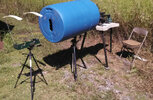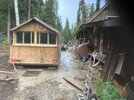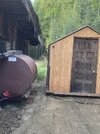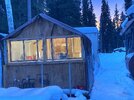Sound propagates as pressure waves from its source in whatever fluid it occurs.
As those pressure waved impact objects, they impute the "impact force" upon that object, which responds following the rules of physics.
Something really rigid and dense, like the precast concrete panels used along freeways, will dissipate the energy in the surface and not re-radiate that energy.
Now, a less-rigid and/or less-dense material can re-eradiate the sound on it's opposite side. This is where
@hso 's idea of two layers of canvas hung a few inches apart can work. The first canvas dumps the sound energy into the air space, then into the next canvas. Each of those "energy transactions" taking a toll" if you will, on the total energy sum at first.
Another scheme is to "pocket" the air between two surfaces using foam, carton eggcrate, spun fiberglass, even mineral wool batts. Each of those has a resiliant face' surface, which "steals" some of the sound energy by being resilient. The "trapped" air in the material tends to not deform to the sound wave (or the geometry "bends" the direction, which also "steals" energy away).
Now, several ranges I'm aware of, simply built lattice works where verticals were arranged down the range, then horizontal lumber set at an angle to the horizontal (45° being very typical) stacked along those posts. The sound waves would "strike" the diagonals, and be reflected down (or up) and away from the horizontal. I know of a rang in Irving, Texas where they set suck baffles, about 3-4 foot tall, about every 25 yards down the range perpendicular to same, and about 6-8 feet above grade. This very much reduced the "noise pollution" at the range.
Now, the downside to this, is that "everything" at a range will wind up with bullet holes in it. Intentional, accidental, whatever. All range features eventually resemble low-quality Swiss cheese (more holes, less cheese). So, any solution used must needs be durable, and also inexpensive, as they also need to be replaceable.
I know of a range where they used precast concrete fencing--which uses a 3" thick panel set between "H" columns. Such fences can provide substantial sound remediation. The panels are replaceable, too. What they are not, is cheap. A couple of hundred yards of such material is going to price out, installed, around a quarter million (presuming 10 foot tall panels). This is a big "bite" on the already sizable physical plant costs of an outdoor range. As would be putting shading tarps or structures over the range (building an angled "shade structure" over the firing line will help mitigate sound at the source, too.

www.youtube.com





